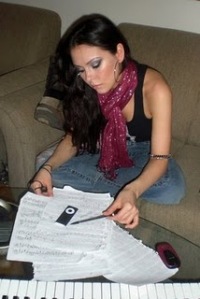 Lola Astanova is one of the very few classical musicians today who has publicly embraced pop music. In fact, she has written piano transcriptions of three popular songs, and posted videos of all of them on YouTube. No one but a classically trained pianist could have written or played these arrangements – they all bristle with technical difficulties – but in each case, Lola has remained true to the spirit of the original.
Lola Astanova is one of the very few classical musicians today who has publicly embraced pop music. In fact, she has written piano transcriptions of three popular songs, and posted videos of all of them on YouTube. No one but a classically trained pianist could have written or played these arrangements – they all bristle with technical difficulties – but in each case, Lola has remained true to the spirit of the original.
Concerning the first video, Lola writes on her website, http://www.lolaastanova.com: “Several months ago, while dancing to Rihanna’s “Don’t Stop The Music” in the club, I thought that it would be fun to turn it into a virtuoso piano piece. So a couple of nights at the keyboard later, I came up with my version of it. I haven’t done anything like that before, and it was a bit of a challenge to capture the original rhythmic pattern on the piano. But I gave it a good try.”
When she recorded the following transcription of Madonna’s “Music”, Lola gave us some fascinating insights into the differences between pop and classical music. Here are a few of the highlights:
“Having been both surprised and amused by the comment, ‘This does not sound like the original,’ that some people posted to my ‘Don’t Stop The Music’ video, this time I decided to give a fair upfront warning: my arrangement is NOT supposed to be the exact repetition of the original song! For my taste, playing a pop song such as ‘Music’ note for note would be among the most boring, unoriginal and unpleasant things to hear, and I would never waste your attention or my time on such tediousness. With that said, my arrangement is, in fact, very closely linked with the original (though, I’ll admit that connecting all the dots may require some musical prowess). So here are a few trivia points about my ‘Music’…
“Pop music and classical music are two polar opposites in the sense that while the richness and variety of electronic sounds allow pop compositions to easily dwell on the same motif over and over again, in classical – it’s all about developing and growing your musical idea. Additionally, the sound of a single instrument (like the piano) is very “thin” compared to the multitude of electronic sounds in a pop song. For these reasons, taking a bare pop theme and playing it on the piano unchanged would be utterly ridiculous. As the original song offered little melodic material, I had to sneak in new motifs (that were still derived from the original) in order to give my ‘Music’ some shape and texture.”
Finally, in the spirit of the holidays, Lola composed the following arrangement of “Jingle Bells”. In this, as in all of these pieces, I hear the clear influence of Franz Liszt, who wrote hundreds of piano transcriptions himself, and who – like Lola – introduced music written for other instruments to a new and vastly wider audience.
In closing, I cannot do better than to echo the comment posted by Steven Mento after the interview with Lola featured on this blog in October: “Brava! Thank you for your extraordinary part in keeping the pianist-composer legacy alive in the 21st century!”